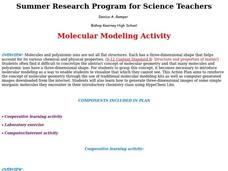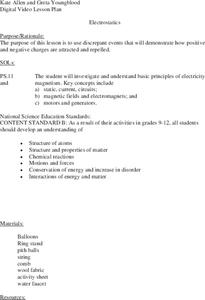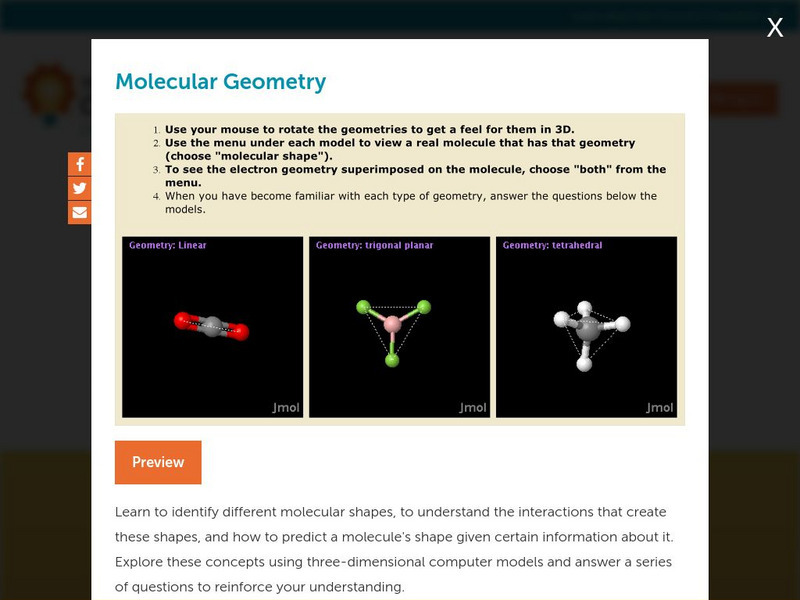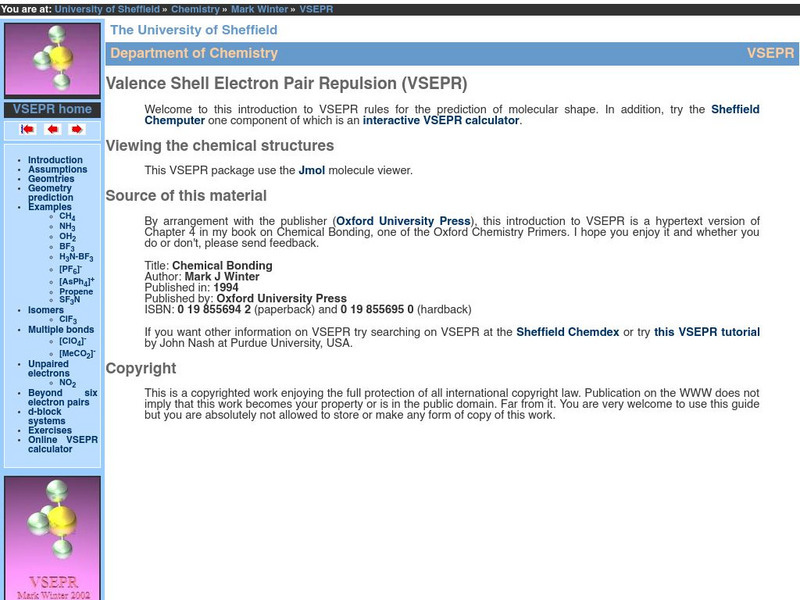Curated OER
Charge It!
Students complete an experiment using balloons to help them examine the concept of static electricity. They discover how engineers use this information to create better air filters for homes. They describe how to charge an insulator as...
Curated OER
Molecular Modeling Activity
Students work together to explain the VSEPR theory and how it relates to molecules. They name electron pairs that can surround the central atom of an organism. They discuss the factors that determine the polarity of a molecule as well.
Curated OER
MINI-UNIT on ELECTRICITY
Young scholars identify hypotheses related to static electricity, to begin to test the hypotheses, to begin to develop conclusions related to observations, to demonstrate that like charges repel and unlike charges attract each other, to...
Curated OER
Molecular Models Laboratory
Students use models to visualize molecular structures. Students read about Lewis dot structures, hybridization, and formal charge. Then students build and draw the molecules and ions given. Students complete 11 pre-lab questions and 4...
Curated OER
Naturally Magnetic Elements
Students explore naturally magnetic elements. In this magnets lesson, students examine the periodic table of elements. Students discover the parts of an atom and determine which three elements are magnetic.
Curated OER
Molecular Structures or Visualizing Molecules
Young scholars identify and describe the molecular structure using the terms of Valance Shell Electron Pair Repulsion. Students predict simply molecular structure in various forms, as well as predict bond structure between atoms of a...
Purdue University
Design of a Door Alarm
How does electricity work? Budding scientists explore the concepts of electrical currents and open and closed circuits with class discussion and a hands-on activity using a battery to turn on a light bulb. Learners also make predictions...
National Energy Education Development Project
Introduction to Solar Energy
People have been using solar energy for many generations to dry crops, heat homes, and for light. This presentation explains how now it is possible to capture the solar energy and store it for future use, details how and where...
Exploratorium
Diamagnetism
If you are attracted to activities dealing with diamagnetism, here is a rare find that you will appreciate. With a neodymium magnet and a few common materials, move a pair of juicy grapes without touching them. Though the fruit is...
Urbana School District
Forces
Is your class struggling with Newton's Second Law? Then show them a presentation that covers everything physics scholars need to know about forces. Starting with gravity, the slides focus on Newton's Laws of Motion, and end with an...
Massachusetts Institute of Technology
Nuclear Synthesis
Start this lesson with a bang! The eighth in a 13-part series of lessons explains the origin of elements beginning with the Big Bang Theory. The reading describes the formation of elements hydrogen through uranium.
Curated OER
Electrostatics
Middle schoolers examine ways positive and negative charges are attracted and repelled by watching teacher demonstrations, and complete activity sheet related to classroom demonstration activities to prove proficiency of knowledge of...
Curated OER
Nuclear Power
In this nuclear power worksheet, students read how atoms can be changes and are unstable. Students compare 3 kinds of radiation and the difference between fission and fusion. Then students complete 10 matching and 2 short answer questions.
Curated OER
Nuclear Power
In this nuclear power worksheet, students compare fission and fusion. Students learn about the different kinds of radiation. This worksheet has 2 short answer questions and 10 matching questions.
Curated OER
Molecular Architecture
Students cuminate their study of molecular structure and bonding with this activity.
Simon Fraser University
Chem1 Virtual Textbook: Atomic Electron Configurations
Acting as a subtopic of the General Chemistry Virtual Textbook's section on Atoms and the Periodic Table, this site discusses a series of topics related to electrons including atoms that have only one electron, effects of...
Simon Fraser University
Chem1 Virtual Textbook: Electron Electron Repulsion
Acting as a subtopic of the General Chemistry Virtual Textbook's section on Atoms and the Periodic Table, this site discusses repulsion of electron pairs. Diagrams and charts of the repulsion are also provided.
Concord Consortium
Concord Consortium: Stem Resources: Molecular Geometry
Students work through animated models showing the effects that electron repulsions have on the shape of a molecule in this web-based activity. In addition, shared and unshared electron pairs are demonstrated to define a molecule's shape....
OpenStax
Open Stax: Andrew R. Barron: Valence Shell Electron Pair Repulsion (Vsepr) Theory
Detailed explanation of Valence Shell Electron Pair Repulsion (VSEPR) Theory with examples and questions for the reader to check comprehension. Also includes step-by-step instructions for correctly building molecules using VSEPR Theory....
Other
Us: Valence Shell Electron Pair Repulsion (Vsepr)
An excellent tutorial that examines VSEPR and pairs of valence electrons. The valence shell electron pair repulsion concept is explored using animated models. Includes a VSEPR calculator. Use the toolbar on the left to navigate through...
Davidson College
Davidson College: Valence Shell Electron Pair Repulsion (Vsepr) Model
Presents examples of molecules that do not match the expected bond angles in the Valence-Shell Electron-Pair Repulsion Model. Requires Java.
Davidson College
Davidson College: Valence Shell Electron Pair Repulsion (Vsepr) Model
Presents exercises where students can check their understanding of the Valence-Shell Electron-Pair Repulsion Model by predicting what a molecular shape will be. Requires Java.
Davidson College
Davidson College: Valence Shell Electron Pair Repulsion (Vsepr) Model
Explains the principles of the Valence-Shell Electron-Pair Repulsion Model, and gives examples of the geometry. Requires Java.
Texas Education Agency
Texas Gateway: Valence Shell Electron Pair Repulsion
Why does the shape of a molecule matter? Learn about how the shape of the molecule not only determines the molecule's properties but also whether it reacts or not. This tutorial reviews of VSEPR and molecular geometry.























